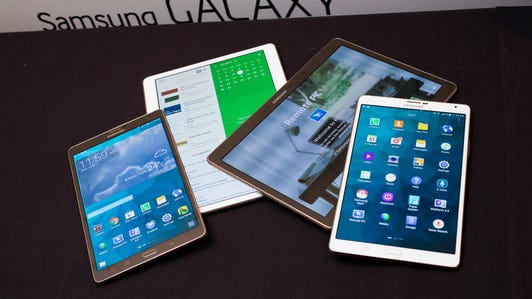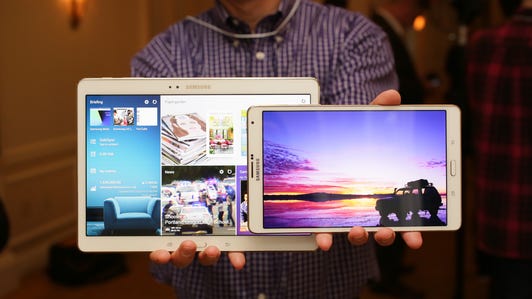
A note connotes something small, a brief comment or a single expression of tone in a piece of music. But the arrival of Samsung’s first Galaxy Note was anything but small, playing perfectly into the company’s “next big thing” campaign.
It was easy to understand that the Galaxy Note was big — even the biggest at the time. Since then, though, the positioning of the Note subbrand has continued to shift. And with Samsung’s release of the Galaxy Tab S, it’s again searching for a defined proposition.
The smartphone that pioneered the phablet category was a polarizing device that set off an arms race — that is, a contest to see which company could produce phones that did the most to tire one’s arms. This resulted in beasts such as the Sony Xperia Z Ultra and Nokia’s Lumia 1520 . Nowadays, 5-inch-plus phones are so common that we’ve started to see something of a backlash with devices such as LG’s G3 making the case that resolution has become the new battlefront in the war for display supremacy.
Indeed, with the release of the Galaxy Mega, it became clear that the Note was large not for the sake of largeness, but for better accommodating its S Pen input device. Nonetheless, even as Samsung outsized the Note with its own Galaxy Mega, the Note retained an air of being Samsung’s top of the line.
Related links
- Samsung’s dizzying array of tablet choices gets dizzier with Galaxy Tab S
- CNET’s take on the Tab S
- Which one’s best for you?: Samsung Galaxy Tab S vs. Note vs. Pro
- Behind Samsung’s push to rule the world
The proposition of the Note subbrand became even more murky with the release of the Galaxy Tab Note tablets. Now, Notehood’s association with a larger screen size was completely gone, but the Note still stood for the high end. And then Samsung added another subbrand — Pro — that spanned its Tab and Note line. It was at least easy to cordon off the Pro as being aimed toward, well, professionals — similar to the MacBook Pro or Surface Pro devices, many pros were drawn to the Note features (hence the Tab Note Pro line).
With the introduction of the Samsung Galaxy Tab S tablets, Samsung has on one hand rationalized its tablet and phone brands on the high end. The Tab S shares an even closer industrial design with the Galaxy S5 than previous Samsung tablets did with phones. And Samsung is doing more than ever to link the two — not only with similar bundled content and features, but with Wi-Fi Direct-based linking features such as taking calls from the tablet similar to those Apple has announced for iOS 8.
But on the other hand, with the Tab S now clearly defined as Samsung’s premium tablet line (at least for content consumption) that once again leaves the Note brand in the weeds. Samsung has promoted Note features in TV commercials. But with other product subbrands now standing on what was once its stage, Samsung has a few options.
It could kill “Note” as a subbrand and just use S Pen as a feature, or it could paint a new positioning map: Tab as the value offering, Tab S as the premium one, Pro for business users, and Note — perhaps — for creatives and students.
The former option is unlikely after the investment Samsung has made in Note, and the latter product line segmentation isn’t perfectly clean. But they beat leaving customers unguided to figure out if a Note product is right for them.
Samsung Galaxy Tab S: Hands-on with Samsung’s newest tablet (pictures)










